Calculation of the number of sections. Calculation of heating radiators: number, sections, power. An approximate calculation is how many battery sections per square meter.
Most likely you have already decided for yourself Which heating radiators are better, but you need to calculate the number of sections. How to perform it accurately and accurately, take into account all errors and heat losses?
There are several calculation options:
- by volume
- by the area of the room
- and a complete calculation including all factors.
Let's consider each of them
Consumption and fixed costs in accounting for heating costs

The legislator has prescribed a bill on consumption-dependent consumption expenditures, however, a certain share of heating costs can also be calculated for square meter... In addition to actual consumption living space or living space are also decisive in the amount of costs charged for warm apartment... The share of consumption is between 50 and 70 percent.
Additional parameters to consider
Fixed costs are especially important for waste heat. In the production and transportation of heat, the energy of the fuel cannot be fully utilized, which leads to costs that cannot be covered by net consumption. Heat escapes from the building, “thawing the heat” of neighbors who heat up less, uninsulated heating pipes or vacancies - all this affects the cost of heating. Therefore, the fixed price has a regulatory effect.
Calculation of the number of heating radiator sections by volume
If you have an apartment in modern house, with double-glazed windows, insulated outer walls and, for the calculation, the value of the thermal power of 34W per 1 cubic meter of volume is already used.
An example of calculating the number of sections:
Room 4 * 5m, ceiling height 2.65m
We get 4 * 5 * 2.65 = 53 cubic meters. The volume of the room and multiply by 41W. Total required thermal power for heating: 2173W.
Heating costs charged for rent
However, the maximum limit of 70% for consumption costs can also be exceeded in accordance with § 10 Heizkosthen B. if agreed by contract. Thus, it is also possible that 100% is charged according to consumption. This value must be present in every case. The result is the cost per unit of consumption. When multiplied with the measured consumption of each individual user, heating costs are calculated according to consumption.
The same method as for consumption costs also applies to heating costs per square meter. For this purpose, all rented square meters for each user group should be aggregated and divided into total costs... The resulting value is "heating costs per m²". If this is multiplied by the square meters of each separate apartment, heating costs are calculated according to the size of the apartment.
Based on the data obtained, it is not difficult to calculate the number of radiator sections. To do this, you need to know the heat transfer of one section of your chosen radiator.
Let's say:
Cast iron MS-140, one section 140W
Global 500,170W
Sira RS, 190W
It should be noted here that the manufacturer or seller often indicates an overestimated heat transfer calculated at an elevated temperature of the coolant in the system. Therefore, focus on the lower value indicated in the product passport.
To get the final heating costs, you need to consider the billing-to-consumption ratio and square meters. If, for example, the coordination of heating costs has been agreed in equal parts, half the size of the apartment is taken as heating costs per sq. M and half the time of consumption of heating costs per unit of consumption. Then both values are added.

Heating costs can already be quite complicated if the tenant lives in the apartment for the entire billing period. But what does it look like when the tenant moves to heating season? After a change of user or each tenant, a separate heat bill will be charged after the end of the heating period. The height of the flow meters of the heat spreaders must be read at the inlet and outlet. This allows heating costs to be taken into account for each tenant.
Let's continue the calculation: we divide 2173 W by the heat transfer of one 170W section, we get 2173W / 170W = 12.78 sections. We round towards an integer, and we get 12 or 14 sections.
Some sellers offer a service for assembling radiators with the required number of sections, that is, 13. But this will no longer be a factory assembly.
This method, like the following, is approximate.
The fixed costs of the apartment are calculated as usual. Hot water is divided into calendar days. With fixed heating costs, distribution can also be carried out in calendar days or according to the number of degrees per day depending on the number of days. Since the average cost of heating is not the same every day, certain daily values are determined for each day, which should correspond to the daily heating costs. Therefore, a day in winter is more expensive than in summer.
Day degree numbers can also be used if the intermediate reading is ignored. Then the consumption can also be determined according to the table. If the apartment cannot be rented directly, there are still consumption costs. They cannot simply be transferred to other tenants, this vacancy should be treated as an independent user instead. Heating costs are charged in the same way as the user. However, the estimated costs must be borne by the landlord.
Calculation of the number of heating radiator sections by the area of the room
It is relevant for a room ceiling height of 2.45-2.6 meters. It is assumed that 100W is enough to heat 1 square meter of area.
That is, for a room of 18 square meters, 18 square meters * 100W = 1800W of thermal power is required.
We divide by the heat transfer of one section: 1800W / 170W = 10.59, that is, 11 sections.
Invoice by number of days
The number of degrees is the calculated amount for determining heat transfer and forms the relationship between room temperature and outside temperature. They can be used to display seasonal fluctuations. The above table shows the proportion specific day accounting for heat costs. It is becoming clear that monthly heating costs differ. Summer days are much cheaper than winter days. The most expensive month is January.
Example of calculation with the number of the evaluation day

Assuming that the heating billing always leaves his house in February, he is obligated to pay the heating bills for the first 4, 5 months. Heating costs are paid as usual at. Below is the calculation. February is not fully included in the tenant's account and therefore can only be accepted on a pro rata basis. In February, $ 5, 35 per day is generated for each day shopping room... This is multiplied by the number of days in the month.
In which direction is it better to round off the calculation results?
The room is corner or with a balcony, then we add 20% to the calculations
If the battery is installed behind a screen or in a niche, then heat loss can reach 15-20%
But at the same time, for the kitchen, you can safely round down, up to 10 sections.
In addition, in the kitchen, it is very often mounted. And this is at least 120 watts of thermal aid per square meter. 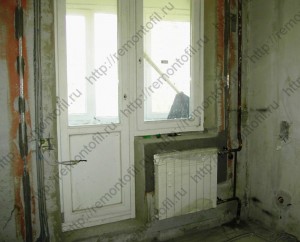
Calculate heating costs: hot water
![]()
Heat cost accounting for hot water is identical to the area where heat is supplied. It should be noted, however, that only the actual living space can be displayed. Storerooms Floor rooms Garages Heating rooms Basements or basements Drying rooms and laundries. Hot water can only be charged if heating is provided via a central hot water supply. If the apartment has its own boiler, only cold water in additional fees.
Accurate calculation of the number of radiator sections
Determine the required thermal power of the radiator using the formula
Qt = 100 watts / m2 x S (premises) m2 x q1 x q2 x q3 x q4 x q5 x q6 x q7
Where the following coefficients are taken into account:
Glazing type (q1)
- Triple glazing q1 = 0.85
- Double glazing q1 = 1.0
- Regular (double) glazing q1 = 1.27
Wall insulation (q2)
If additional payment is required for heating costs. With warm rent, living space is paid and additional expenses... Although the cold lease is fixed, ancillary and / or operating costs are always prepayment only. This is based on an estimate of consumption. Defined values can only be determined with annual reports... If tenants can save on heating costs, they may have surrendered too much to the landlord. Then there is the possibility that this surplus will be returned again, but it is also possible billing in the next year.
- High-quality modern insulation q2 = 0.85
- Brick (in 2 bricks) or insulation q3 = 1.0
- Bad insulation q3 = 1.27
The ratio of the area of windows to the area of the floor in the room (q3)
- 10% q3 = 0.8
- 20% q3 = 0.9
- 30% q3 = 1.0
- 40% q3 = 1.1
- 50% q3 = 1.2
Minimum outdoor temperature (q4)
- -10С q4 = 0.7
- -15С q4 = 0.9
- -20С q4 = 1.1
- -25С q4 = 1.3
- -35С q4 = 1.5
Number of exterior walls (q5)
When is the limitation period for calculating heating costs set?
In the case especially cold winter or when fuel prices are increased, heating costs can also be higher. In this case, the affected person must make an additional payment. You can also increase your monthly discount. 
Of course, there is also a deadline for billing heating. When the requirement to make an additional payment becomes prohibited by law, it is regulated by law. Basically, the landowner has three years to qualify for the heating bill.
- One (usually) q5 = 1.1
- Two ( corner apartment) q5 = 1,2
- Three q5 = 1.3
- Four q5 = 1.4
Room type above the calculated one (q6)
- Heated room q6 = 0.8
- Heated attic q6 = 0.9
- Cold attic q6 = 1.0
Ceiling height (q7)
- 2.5m q7 = 1.0
- 3.0m q7 = 1.05
- 3.5m q7 = 1.1
- 4.0m q7 = 1.15
- 4.5m q7 = 1.2
Calculation example:
If the tenant remains the default, the limitation period can be reduced, For example, for a stopover. Sub-payments and negotiations over heating demand also prevent the deadline from being passed. The same applies to the tenant. Reimbursement should be limited after three years.
What if you need a very accurate calculation?
You also need to pay attention to the billing period, which the owner must leave in writing and send the heating bill. After this period, the landlord can no longer demand additional payment. Tenants must also adhere to their deadlines. After receiving the heating bill, they have one year to express their objections. Potential claims are then prohibited by law.
100 w / m2 * 18m2 * 0.85 (triple glazing) * 1 (brick) * 0.8
(2.1 m2 window / 18m2 * 100% = 12%) * 1.5 (-35) *
1.1 (one outdoor) * 0.8 (heated, apartment) * 1 (2.7m) = 1616W
Poor wall insulation will increase this value to 2052 W!
number of heating radiator sections: 1616W / 170W = 9.51 (10 sections)
How to calculate heating radiators so that the temperature in the apartment is extremely comfortable is a question that arises for everyone who decides to repair. Too few sections will not completely warm up the room, and an excess will only entail too much spending on utilities... So what needs to be considered in order to correctly calculate the size of the batteries?
Assessment of the degree of insulation of a house element and the required thickness of thermal insulation
Upfront payments for operating expenses should be set annually; Taking into account the principle of cost-effectiveness. Billing must be notified to the lessee no later than the end of the twelfth month after the end of the billing period. After this period, the landlord is excluded from the claim unless the landlord is liable for the delay. The landlord is not obliged to make partial payments. The tenant must notify the landlord of the facts no later than the end of the twelfth month after receiving the invoice.
Preliminary preparation
What must be considered to calculate the power of a heating radiator per room:
- define temperature regime and potential thermal loss;
- develop optimal technical solutions;
- determine the type of heating equipment;
- establish financial and thermal criteria;
- take into account the reliability and technical specifications heating appliances;
- draw up heat pipe diagrams and location of batteries for each room;
It is rather difficult to calculate the number of heating radiator sections without the help of specialists and additional programs. To make the calculation more accurate, you cannot do without a thermal imager or specially installed programs for this.
After this period, the lessee can no longer object to any objections if the lessee is not liable for the deferred performance. 
If the calculation of the cost of heat is too high or other inconsistencies arise, you should read the document more carefully. If the landlord has a complaint, it is worth checking to see if the invoice deadline is already running out. In this case, you do not need to pay an additional fee.

What happens if the calculations are wrong? The main consequence is more low temperature in the premises, and, consequently, the operating conditions will not correspond to the desired. Too powerful heating devices will lead to excessive spending both on the devices themselves and their installation, and on utilities.
Other common payment mistakes. Wrong allocation key Consumption was incorrectly estimated Rent change was incorrectly calculated.
- The area is not correct.
- The rest of the apartments were transferred to tenants.
Self-calculations
You can roughly calculate how much power the batteries should be using only a tape measure to measure the length and width of the walls and a calculator. But the accuracy of such calculations is extremely low. The error will be 15-20%, but this is quite acceptable.

Calculations depending on the type of heaters
When choosing a model, keep in mind that the heat output depends on the material from which they are made. Sizing Methods sectional batteries do not differ, but the results will be different. There are average values. It is worth focusing on them when choosing the optimal number heating appliances... Capacities of heaters with 50 cm sections:
- aluminum batteries - 190 W;
- bimetallic - 185 W;
- cast iron heating devices - 145 W;

- aluminum - 1.9-2 square meters;
- aluminum and steel - 1.8 square meters;
- cast iron - 1.4-1.5 square meters;
Here is an example of calculating the number of sections of aluminum radiators. Let's say that the size of the room is 16 sq. M. It turns out that a room of this size needs 16m2 / 2m2 = 8 pcs. By the same principle, count for cast iron or bimetallic devices... It is only important to know exactly the norm - the above parameters are correct for models with a height of 0.5 meters.
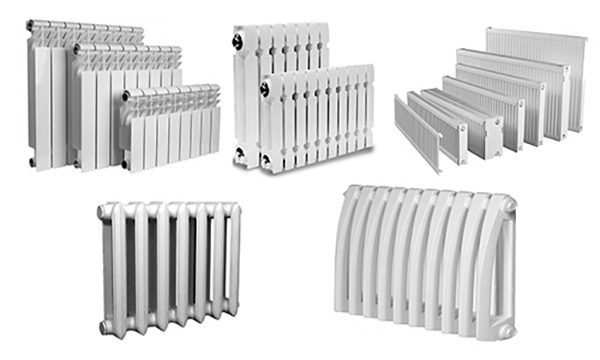
On this moment models from 20 to 60 cm are produced. Accordingly, the area that the section can heat will differ. The smallest models are curb, 20 cm high.If you decide to purchase a heating unit custom sizes, then the calculation formula will have to be adjusted. Look for the necessary data in the data sheet.
When making adjustments, it should be borne in mind that the size of the batteries directly affects the heat transfer. Therefore, the smaller the height with the same width, the less area, and with them the power. For correct calculations, find the ratio of the heights of the selected model and the standard one, and with the help of the data obtained, correct the result.
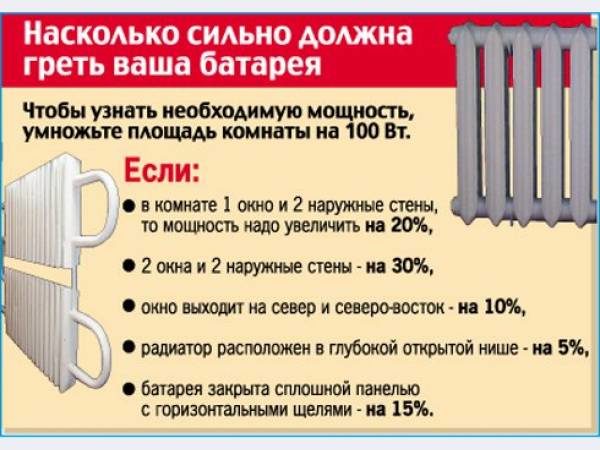
Let's say you have chosen a model with a height of 40 cm.In this case, the calculation of the number of sections of aluminum heating radiators per room area will look like this:
- we will use the previous calculations: 16m2 / 2m2 = 8 pieces;
- calculate the ratio 50cm / 40cm = 1.25;
- correct the calculations according to the basic formula - 8pcs * 1.25 = 10 pcs.
The calculation of the number of heating radiators by volume begins first of all with the collection of the necessary information. What parameters need to be taken into account:
- Housing area.
- Ceiling height.
- Number and area of door and window openings.
- Temperature conditions outside the window during the heating season.
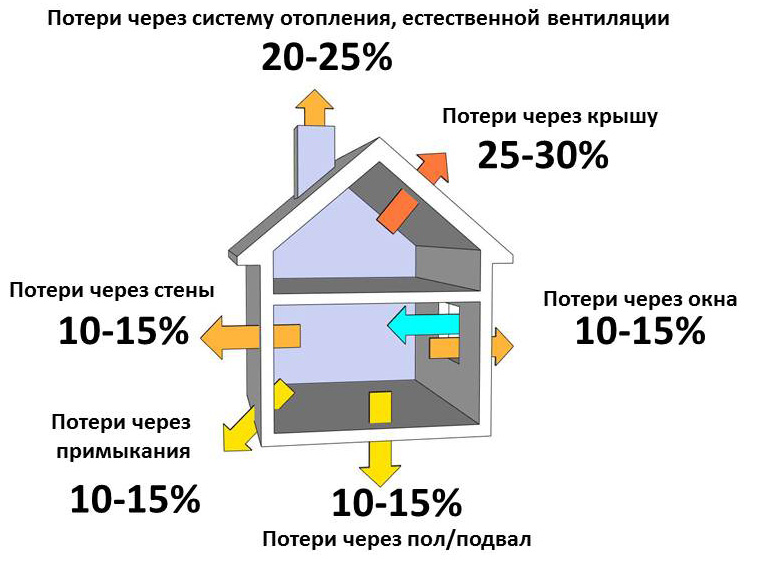
The norms and rules established for the power of heating partitions regulate the minimum permissible indicator per sq. meter of the apartment - 100 W. The calculation of heating radiators by the volume of the room will be more accurate than the one in which only the length and width are taken as the basis. The final results are adjusted depending on the individual characteristics of a particular room. This is done by multiplying by a correction factor.
When calculating the power of heating devices, the average ceiling height is taken - 3 m.For apartments with a ceiling of 2.5 meters, this coefficient will be 2.5m / 3m = 0.83, for apartments with high ceilings 3.85 meters - 3.85m / 3m = 1.28. Corner rooms will require additional adjustments. The totals are multiplied by 1.8.
The calculation of the number of heating radiator sections by the volume of the room should be carried out with correction if there is one window in the room big size or several windows at once (coefficient 1.8).

The bottom connection will also require you to make your own adjustments. For such a case, the coefficient will be 1.1.
In areas with extreme weather conditions, where winter temperatures reach record lows, the capacity should be doubled.
Plastic double-glazed windows, on the contrary, will require an adjustment downward, a factor of 0.8 is taken as a basis.
The above data are averaged values, since they were not additionally taken into account:
- thickness and material of walls and floors;
- glazing area;
- flooring material;
- the presence or absence of insulation on the floor;
- curtains and curtains in window openings.
Additional parameters for more accurate calculations

An accurate calculation of the number of heating radiators per area will not do without data from technical documents. This is important in order to more accurately determine the value of heat loss. The best way to determine the level of heat loss is with a thermal imager. The device will quickly identify the coldest areas in the room.
Everything would be much easier if each apartment was built according to a standard layout, but this is far from the case. Each house or city apartment has its own characteristics. Taking into account many characteristics (the number of window and doorways, wall heights, housing area, etc.), the question naturally arises: how to calculate the number of heating radiators?
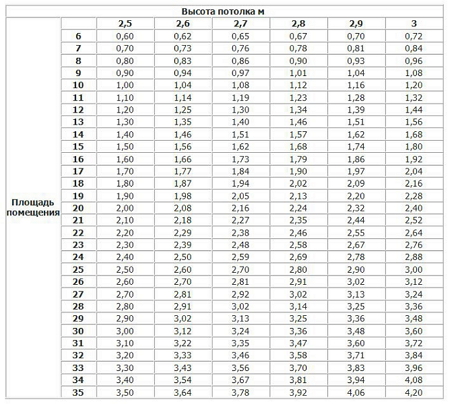
The peculiarities of the exact technique are that more coefficients are needed for calculations. One of important values that needs to be calculated is the amount of heat. The formula is different from the previous ones and looks like this: KT = 100 W / m2 * P * K1 * K2 * K3 * K4 * K5 * K6 * K7.
More about each meaning:
- CT is the amount of heat that is needed for heating.
- P - room size m2.
- K1 - the value of this coefficient takes into account the quality of window glazing: double - 1.27; plastic windows with double glazing- 1.0; with a triple - 0.85.
- K2 - coefficient taking into account the level thermal insulation characteristics walls: low - 1.27; good (e.g. two-layer brickwork) - 1.0; high - 0.85.
- K3 - this value takes into account the ratio of the areas of window openings and floors: 50% - 1.2; 40% - 1.1; 30% - 1.0; 20% - 0.9; 10% - 0.8.
- K4 - coefficient depending on the average temperature indicators of air in winter time years: - 35 ° С - 1.5; - 25 ° C - 1.3; - 20 ° C - 1.1; - 15 ° C - 0.9; -10 ° C - 0.7.
- K5 depends on the number external walls buildings, the data of this coefficient are as follows: one - 1.1; two - 1.2; three - 1.3; four - 1.4.
- K6 is calculated based on the type of premises located on the floor above: attic - 1.0; heated attic room - 0.9; heated apartment - 0.8.
- K7 - the last of the correction values and depends on the height of the ceiling: 2.5 m - 1.0; 3.0 m - 1.05; 3.5 m - 1.1; 4.0 m - 1.15; 4.5 m - 1.2.
The described calculation of sections of heating batteries by area is the most accurate, since it takes into account much more nuances. The number obtained in the course of these calculations is divided by the value of heat transfer. The final result is rounded to the nearest whole number.
Correction for temperature conditions
The technical passport of the heater indicates maximum power... For example, at a water temperature in the heat pipe of 90 ° C during supply and 70 ° C in the reverse mode, the apartment will be + 20 ° C. Such parameters are usually denoted as follows: 90/70/20, but the most common capacities in modern apartments- 75/65/20 and 55/45/20.

For the correct calculation, you must first calculate the temperature head - this is the difference between the temperature of the battery itself and the air in the apartment. Please note that the average value between the flow and return temperatures is taken for calculations.
How to calculate the number of sections of aluminum radiators, taking into account the above parameters? For a better understanding of the issue, calculations will be made for aluminum batteries in two modes: high-temperature and low-temperature (calculation for standard models height 50 cm). The dimensions of the room are the same - 16 square meters.
One section aluminum radiator in 90/70/20 mode heats 2 square meters., therefore, for full heating of the room, 16m2 / 2m2 = 8 pcs. When calculating the size of batteries for 55/45/20 mode, you need to first calculate the temperature head. So, the formulas for both systems:
- 90/70/20 - (90 + 70) / 2-20 = 60 ° C;
- 55/45/20 - (55 + 45) / 2-20 = 30 ° C.

Therefore, in low-temperature mode, it is necessary to increase the size of the heating devices by 2 times. Taking into account this example, on a room of 16 sq. meters need 16 aluminum sections... Please note that for cast iron appliances you will need 22 sections with the same area of the room and with the same temperature systems. Such a battery will turn out to be too large and massive, therefore cast iron is least of all suitable for low-temperature structures.
Using this formula, you can easily calculate how many radiator sections are needed per room, taking into account the desired temperature regime. To make the apartment + 25 ° C in winter, just change the temperature data in the thermal head formula, and substitute the resulting coefficient in the formula for calculating the size of the batteries. Suppose, with the parameters 90/70/25, the coefficient will be as follows: (90 + 70) / 2 - 25 = 55 ° С.
If you don't want to waste time calculating heating radiators, you can use online calculators or special programs installed on your computer.
How to use an online calculator
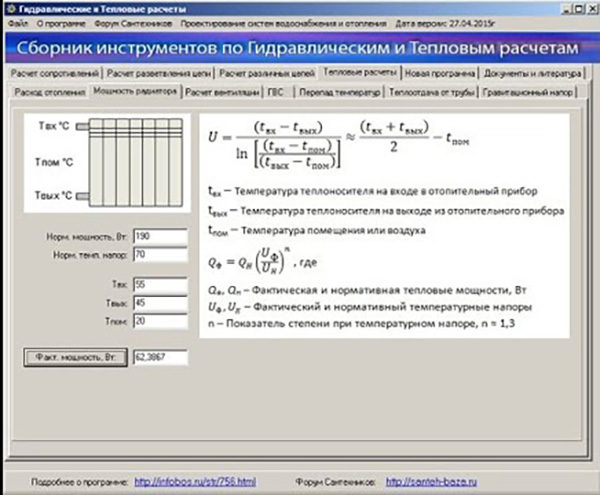
Calculate how many sections of heating radiators per sq. you will need a meter, you can use special calculators that will calculate everything in the blink of an eye. Such programs can be found on the official websites of some manufacturers. Using these calculators is easy. Just enter all the relevant data in the fields and you will instantly receive an accurate result. To calculate how many sections of heating radiators are needed per square meter, you need to enter data (power, temperature, etc.) for each room separately. If the rooms are not separated by doors, add up their overall dimensions, and heat will spread through both rooms.

In order to avoid inaccuracies in the calculations, carefully enter all the parameters and check how accurate the data you have indicated in the corresponding fields. It is better to double-check several times than to experience the consequences of your mistakes in the form of too low or high temperature in the House.
Summarizing
So, from the above formulas it is clear how to correctly calculate aluminum (cast iron, bimetallic, etc.) radiators for an apartment. As you can see, this is not a complicated matter. The main thing is attentiveness and accuracy. To get the most accurate data, use special equipment.
